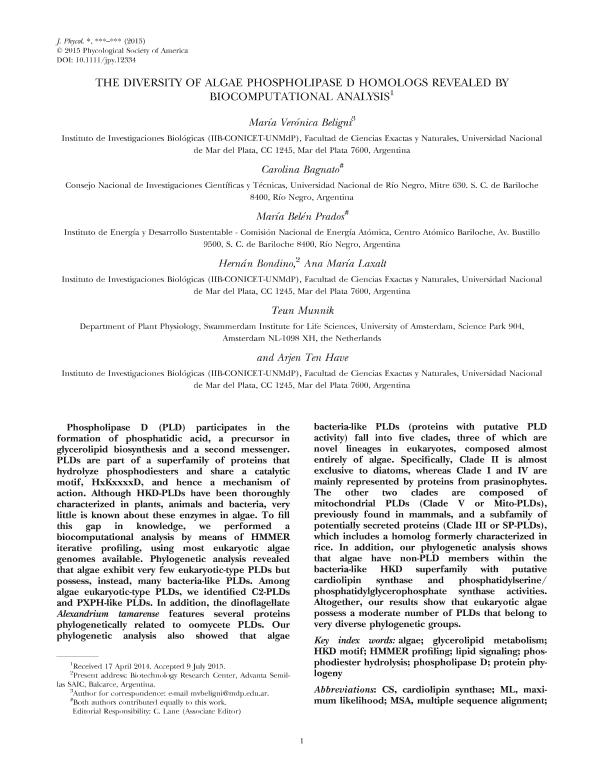Artículo
The diversity of algal phospholipase D homologs revealed by biocomputational analysis
Beligni, María Verónica ; Bagnato, Carolina
; Bagnato, Carolina ; Prados, Maria Belen
; Prados, Maria Belen ; Bondino, Hernán Gabriel
; Bondino, Hernán Gabriel ; Laxalt, Ana Maria
; Laxalt, Ana Maria ; Munnik, Teun; Ten Have, Arjen
; Munnik, Teun; Ten Have, Arjen
 ; Bagnato, Carolina
; Bagnato, Carolina ; Prados, Maria Belen
; Prados, Maria Belen ; Bondino, Hernán Gabriel
; Bondino, Hernán Gabriel ; Laxalt, Ana Maria
; Laxalt, Ana Maria ; Munnik, Teun; Ten Have, Arjen
; Munnik, Teun; Ten Have, Arjen
Fecha de publicación:
10/2015
Editorial:
Wiley Blackwell Publishing, Inc
Revista:
Journal Of Phycology
ISSN:
0022-3646
Idioma:
Inglés
Tipo de recurso:
Artículo publicado
Clasificación temática:
Resumen
Phospholipase D (PLD) participates in the formation of phosphatidic acid, a precursor in glycerolipid biosynthesis and a second messenger. PLDs are part of a superfamily of proteins that hydrolyze phosphodiesters and share a catalytic motif, HxKxxxxD, and hence a mechanism of action. Although HKD-PLDs have been thoroughly characterized in plants, animals and bacteria, very little is known about these enzymes in algae. To fill this gap in knowledge, we performed a biocomputational analysis by means of HMMER iterative profiling, using most eukaryotic algae genomes available. Phylogenetic analysis revealed that algae exhibit very few eukaryotic-type PLDs but possess, instead, many bacteria-like PLDs. Among algae eukaryotic-type PLDs, we identified C2-PLDs and PXPH-like PLDs. In addition, the dinoflagellate Alexandrium tamarense features several proteins phylogenetically related to oomycete PLDs. Our phylogenetic analysis also showed that algae bacteria-like PLDs (proteins with putative PLD activity) fall into five clades, three of which are novel lineages in eukaryotes, composed almost entirely of algae. Specifically, Clade II is almost exclusive to diatoms, whereas Clade I and IV are mainly represented by proteins from prasinophytes. The other two clades are composed of mitochondrial PLDs (Clade V or Mito-PLDs), previously found in mammals, and a subfamily of potentially secreted proteins (Clade III or SP-PLDs), which includes a homolog formerly characterized in rice. In addition, our phylogenetic analysis shows that algae have non-PLD members within the bacteria-like HKD superfamily with putative cardiolipin synthase and phosphatidylserine/phosphatidylglycerophosphate synthase activities. Altogether, our results show that eukaryotic algae possess a moderate number of PLDs that belong to very diverse phylogenetic groups.
Archivos asociados
Licencia
Identificadores
Colecciones
Articulos(CCT - MAR DEL PLATA)
Articulos de CTRO.CIENTIFICO TECNOL.CONICET - MAR DEL PLATA
Articulos de CTRO.CIENTIFICO TECNOL.CONICET - MAR DEL PLATA
Citación
Beligni, María Verónica; Bagnato, Carolina; Prados, Maria Belen; Bondino, Hernán Gabriel; Laxalt, Ana Maria; et al.; The diversity of algal phospholipase D homologs revealed by biocomputational analysis; Wiley Blackwell Publishing, Inc; Journal Of Phycology; 51; 5; 10-2015; 943-962
Compartir
Altmétricas



